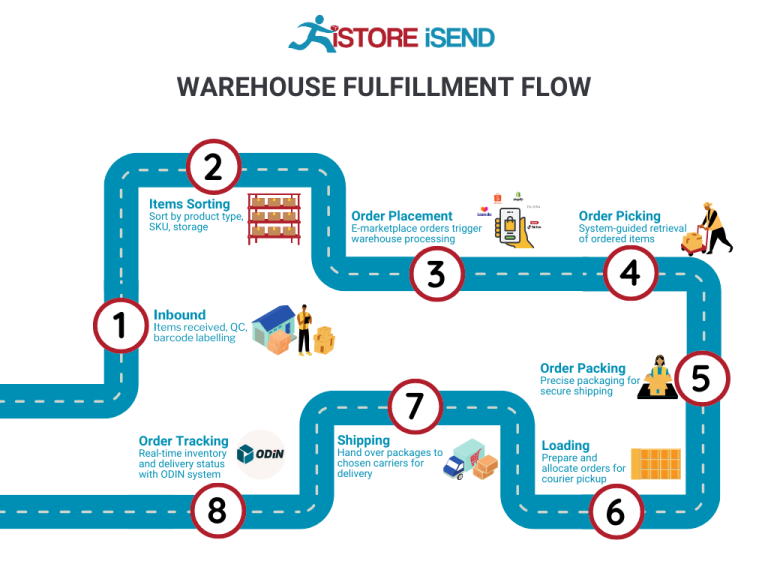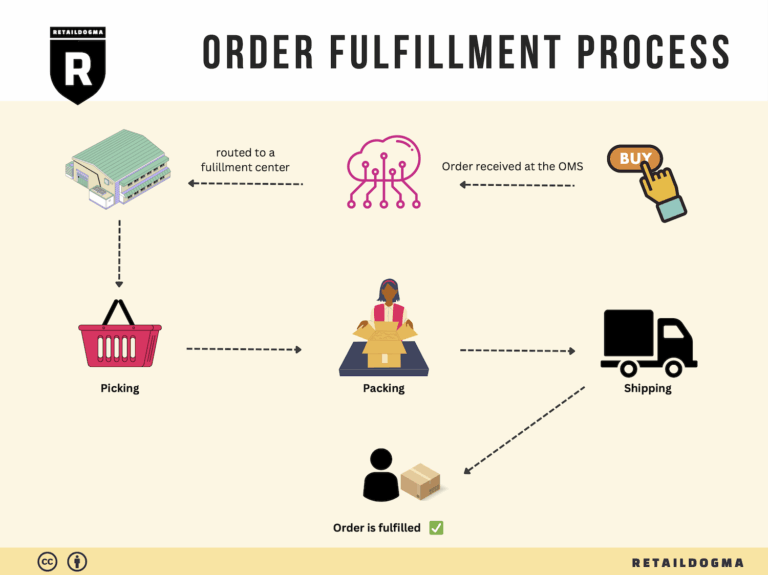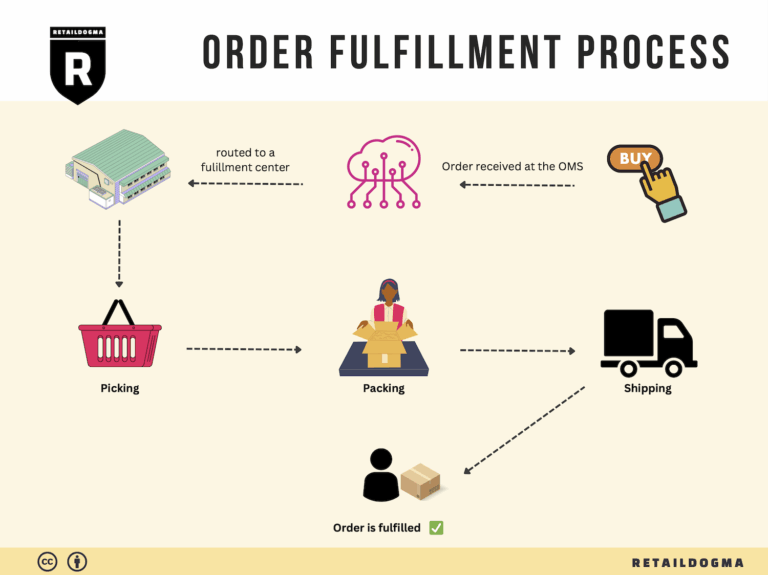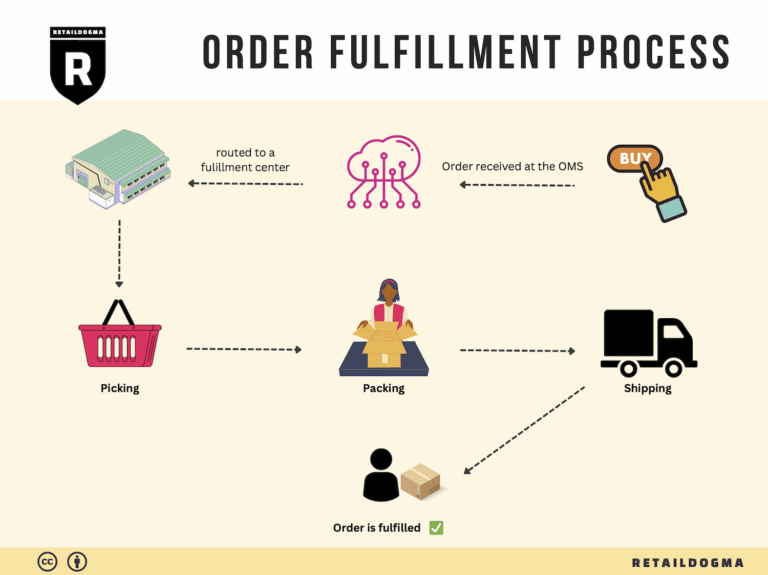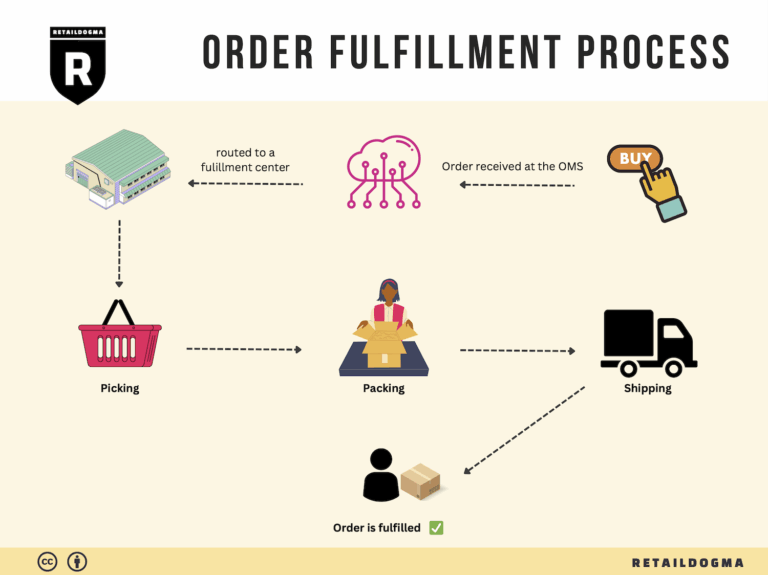How Order Fulfillment Works: A Step-by-Step Guide for Businesses
What is E-commerce Fulfillment? An Introduction for Growing Businesses
Understanding the Challenges of E-commerce Fulfillment
As an e-commerce business owner, one of the most common pain points you may encounter is the overwhelming nature of packing and shipping orders. The excitement of growing sales can quickly turn into stress when you face the logistical challenges of fulfilling those orders efficiently. From managing inventory to ensuring timely deliveries, the fulfillment process can become a daunting task that detracts from your core business activities.
At its essence, e-commerce fulfillment is the process of getting a product to a customer after an order is placed. This involves a series of steps that include receiving inventory, storing products, picking and packing orders, and shipping them to the customer’s doorstep. For many growing businesses, mastering these steps is crucial to maintaining customer satisfaction and scaling operations effectively.
What This Guide Will Cover
This comprehensive guide is designed to demystify e-commerce fulfillment and provide you with the insights necessary to streamline your logistics. We will delve into various fulfillment models available to you, such as Third-Party Logistics (3PL) and Fulfilled by Amazon (FBA), each with its own set of advantages and considerations.
Moreover, we will explore the core services that fulfillment partners typically offer, including inventory management, order processing, and shipping solutions. Understanding these services will help you assess your needs and determine the best fit for your business.
Choosing the right fulfillment partner is a critical decision that can impact your operational efficiency and customer satisfaction. We will provide practical tips on how to evaluate potential partners, including key questions to ask and factors to consider, such as technology integration and scalability.
Pricing is another essential aspect of fulfillment that many business owners struggle to navigate. This guide will outline common pricing structures and what to expect in terms of costs, enabling you to budget effectively and avoid unexpected expenses.
Empowering Your Business Decisions
Ultimately, our goal is to empower you to make informed decisions about your logistics strategy. By understanding the intricacies of e-commerce fulfillment, you will be better equipped to select the right partners, streamline your operations, and focus on what truly matters—growing your business and delighting your customers. With the right knowledge and resources, you can transform fulfillment from a headache into a competitive advantage.
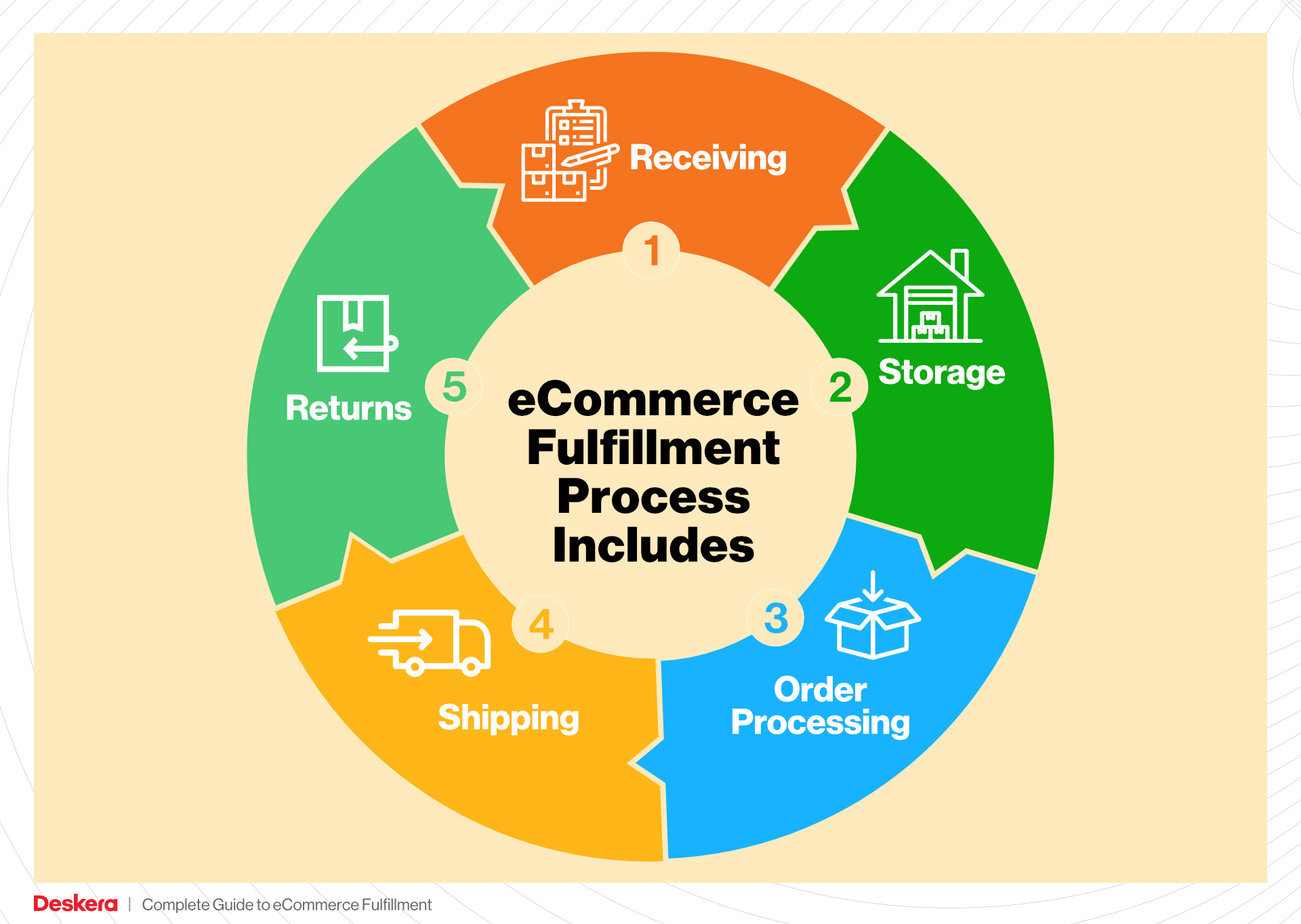
What You’ll Learn In This Guide
- What is E-commerce Fulfillment? An Introduction for Growing Businesses
- The Order Fulfillment Process: From ‘Buy’ Button to Customer’s Door
- Comparing Fulfillment Models: In-House vs. 3PL vs. Dropshipping
- A Deep Dive into Amazon FBA: Pros, Cons, and Who It’s For
- Core Services Offered by Fulfillment Centers
- How to Choose a Fulfillment Partner: A 6-Point Checklist
- Understanding Fulfillment Pricing: A Breakdown of Common Fees
- Frequently Asked Questions (FAQs) about Fulfillment
- Conclusion: Is Outsourcing Fulfillment the Right Move for Your Business?
- Important Disclaimer
The Order Fulfillment Process: From ‘Buy’ Button to Customer’s Door
1. Receiving Inventory
The order fulfillment process begins with receiving inventory, a crucial step that ensures the accuracy and quality of the products entering the warehouse. When products arrive at the fulfillment center, they undergo a receiving process where they are checked against purchase orders for quantity and quality. This step is vital as it helps identify discrepancies or damages before the products are stored.
Key Term: SKU (Stock Keeping Unit) – Each product is assigned a unique SKU, which facilitates efficient tracking and management within the warehouse system. By using SKUs, businesses can maintain accurate inventory records, reducing the risk of stockouts or overstock situations.
2. Warehouse Storage
Once the inventory is received and verified, it is moved to warehouse storage. This step involves organizing products in a manner that maximizes space and improves accessibility. Efficient storage solutions, such as shelving, pallets, and bins, are essential for maintaining an orderly warehouse environment.
Importance: Proper storage not only helps in optimizing space utilization but also enhances picking efficiency during order fulfillment. The layout of the warehouse can significantly impact how quickly orders are processed, making strategic storage a key factor in scaling operations.
Key Term: FIFO (First In, First Out) – This inventory management technique ensures that older stock is sold before newer stock, which is particularly important for perishable goods. Implementing FIFO can help businesses minimize waste and improve inventory turnover.
3. Order Picking
The next step in the fulfillment process is order picking, where warehouse associates gather the items needed to fulfill customer orders. This step is critical as it directly impacts order accuracy and customer satisfaction. The picking process can vary in complexity based on the size and type of orders.
Importance: Efficient picking strategies, such as batch picking or wave picking, can significantly reduce the time taken to fulfill orders. This not only speeds up delivery times but also minimizes labor costs, thereby enhancing overall profitability.

Key Term: Pick Lists – A pick list is a document or digital tool that outlines the items and quantities needed for a specific order. By utilizing pick lists, warehouse associates can streamline the picking process and reduce errors, ensuring that customers receive the correct products.
4. Order Packing
After items have been picked, they proceed to the order packing stage. Here, products are carefully packed to ensure they arrive at the customer’s door in pristine condition. This step involves selecting the appropriate packaging materials and labeling the packages for shipping.
Importance: Effective packing not only protects products during transit but also enhances the unboxing experience for customers. A well-packed order can lead to higher customer satisfaction and repeat business, which is critical for scaling e-commerce operations.
Key Term: Packing Slip – A packing slip is a document included in the package that lists the items contained within. It serves as a confirmation for customers and can help reduce return requests due to order discrepancies.
5. Shipping & Delivery
The final step in the order fulfillment process is shipping and delivery. Once orders are packed, they are shipped to the customer using various carriers, depending on service levels and cost considerations. This step is crucial for ensuring that customers receive their orders promptly.
Importance: Timely delivery is a key component of customer satisfaction in e-commerce. Implementing efficient shipping strategies, such as leveraging multiple carriers or offering expedited shipping options, can significantly enhance the customer experience and drive repeat purchases.
Key Term: Last Mile Delivery – This term refers to the final leg of the delivery journey, where packages are transported from a distribution center to the customer’s doorstep. Optimizing last mile delivery is essential for minimizing shipping costs and improving delivery times, which are critical for maintaining competitive advantage in the e-commerce landscape.
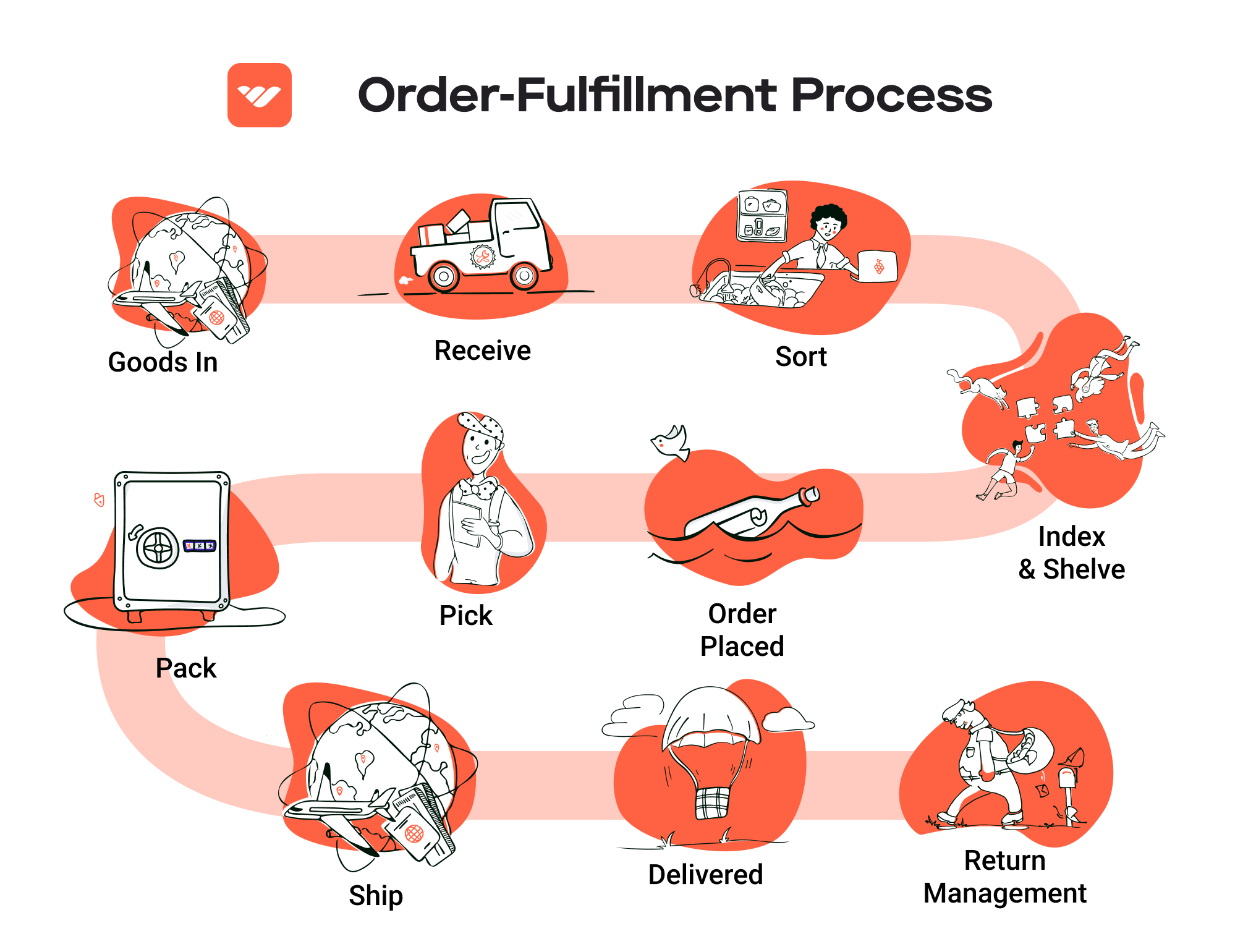
In conclusion, understanding and optimizing each step of the order fulfillment process is essential for e-commerce business owners and operations managers looking to scale their logistics efficiently. By focusing on these five key areas—receiving inventory, warehouse storage, order picking, order packing, and shipping & delivery—businesses can enhance their overall operational efficiency, improve customer satisfaction, and drive sustainable growth.
Comparing Fulfillment Models: In-House vs. 3PL vs. Dropshipping
Comparison of Fulfillment Models
| Model | Who Handles Inventory | Best For (Business Stage) | Key Advantage | Key Disadvantage |
|---|---|---|---|---|
| In-House Fulfillment | The business itself | Established businesses | Greater control over inventory and customer experience | Higher overhead costs and operational complexity |
| Third-Party Logistics (3PL) | An external logistics provider | Growing businesses | Scalability and flexibility in logistics | Less control over inventory and processes |
| Dropshipping | Suppliers or manufacturers | Startups and small businesses | Low upfront investment and minimal risk | Lower profit margins and reliance on suppliers |
In-House Fulfillment
In-house fulfillment involves managing the entire logistics process within the business itself. This model is typically adopted by established businesses that have sufficient resources and infrastructure to handle inventory, storage, and shipping. One of the primary advantages of in-house fulfillment is the high level of control it provides over the inventory and customer experience. Businesses can implement personalized packaging, ensure quality control, and maintain consistent branding throughout the fulfillment process. However, this model also comes with significant disadvantages, including high overhead costs related to warehousing, staffing, and technology investments. Additionally, operational complexity can increase as businesses scale, requiring more sophisticated inventory management systems and staffing solutions.
Third-Party Logistics (3PL)
Third-party logistics (3PL) is a model where businesses outsource their logistics and fulfillment operations to an external provider. This approach is particularly beneficial for growing businesses that need to scale their operations without the burden of managing logistics in-house. 3PL providers typically offer a range of services, including warehousing, inventory management, and shipping, allowing businesses to focus on their core competencies, such as product development and marketing. The key advantage of using a 3PL is the scalability and flexibility it provides, allowing businesses to quickly adjust to changes in demand or market conditions without significant capital investment. However, a potential downside is the reduced control over inventory and fulfillment processes, which can lead to inconsistencies in customer experience if the 3PL provider does not meet the business’s quality standards.
Dropshipping
Dropshipping is a fulfillment model where businesses sell products without holding any inventory. Instead, when a customer places an order, the business purchases the item from a third-party supplier, who then ships it directly to the customer. This model is particularly attractive for startups and small businesses due to its low upfront investment and minimal risk. Since there is no need to invest in inventory or manage storage, businesses can focus on marketing and customer acquisition. However, dropshipping also presents challenges, such as lower profit margins due to reliance on suppliers and potential issues with product quality and shipping times. Furthermore, businesses have limited control over inventory levels and fulfillment processes, which can affect the overall customer experience.
Conclusion
Choosing the right fulfillment model is crucial for the success and scalability of an e-commerce business. Each model—In-house fulfillment, 3PL, and dropshipping—offers distinct advantages and disadvantages that cater to different business stages and strategies. Established businesses may find in-house fulfillment beneficial for maintaining control, while growing companies might leverage the scalability of 3PL services. Conversely, startups can capitalize on the low-risk nature of dropshipping to enter the market quickly. Ultimately, understanding the unique needs of your business and aligning them with the appropriate fulfillment model will be key to optimizing your operations and enhancing customer satisfaction.
A Deep Dive into Amazon FBA: Pros, Cons, and Who It’s For
Understanding Fulfillment by Amazon (FBA)
Fulfillment by Amazon (FBA) is a service provided by Amazon that allows sellers to store their products in Amazon’s fulfillment centers. Amazon takes care of storage, packaging, and shipping to customers, as well as handling customer service and returns. This service allows e-commerce businesses to leverage Amazon’s vast logistics network, making it easier to reach millions of customers worldwide.
How FBA Works
-
Setup: Sellers create an Amazon seller account and choose FBA as their fulfillment method. They list their products on Amazon and prepare them for shipment to Amazon’s fulfillment centers.
-
Shipping Inventory: Sellers send their products to Amazon’s warehouses. The products are then stored until they are sold.
-
Order Fulfillment: When a customer places an order, Amazon picks, packs, and ships the product directly to the customer. This process is designed to be efficient and quick, often resulting in same-day or next-day delivery.
-
Customer Service: Amazon handles customer inquiries, returns, and refunds. This allows sellers to focus on other aspects of their business.
-
Payments: After a sale, Amazon deducts its fees from the sale price and transfers the remaining funds to the seller’s account.
Pros of Using FBA
-
Prime Eligibility: One of the most significant advantages of FBA is that products become eligible for Amazon Prime. This can significantly increase sales, as Prime members often prefer items that qualify for free two-day shipping.
-
Customer Trust: Products fulfilled by Amazon benefit from the trust associated with Amazon’s brand. Customers are more likely to purchase items that they know will be delivered quickly and reliably.
-
Multi-Channel Fulfillment: FBA allows sellers to fulfill orders from other platforms, such as their own e-commerce website or eBay, using Amazon’s logistics. This provides flexibility and can streamline operations for businesses selling across multiple channels.
-
Scalability: FBA can help businesses scale quickly. Since Amazon handles storage and shipping, sellers can focus on sourcing new products and growing their business without worrying about logistics.
-
Time-Saving: By outsourcing fulfillment to Amazon, sellers can save significant time and resources. This allows them to concentrate on marketing, product development, and customer engagement.
-
Advanced Analytics: Amazon provides sellers with detailed reports and analytics, allowing them to track performance, inventory levels, and customer behavior. This data can be instrumental in making informed business decisions.
Cons of Using FBA
-
High Fees: FBA comes with various fees, including storage fees and fulfillment fees. These can eat into profit margins, especially for low-cost or low-margin products. Sellers must carefully calculate these costs to ensure profitability.
-
Strict Inventory Rules: Amazon has stringent inventory management policies. Sellers must adhere to specific guidelines regarding packaging, labeling, and inventory limits. Failure to comply can result in additional fees or account suspension.
-
Commingling Risks: FBA operates on a commingling model, meaning that inventory from different sellers can be stored together. This poses risks, such as the possibility of receiving damaged or counterfeit items, which can harm seller reputations.
-
Less Control Over Fulfillment: While outsourcing fulfillment can save time, it also means less control over the packaging and shipping process. Sellers may find it challenging to maintain their brand’s identity and customer experience.
-
Complex Returns Process: While Amazon handles customer returns, this can sometimes lead to complications for sellers, especially if items are returned damaged or if inventory levels are inaccurately reflected.
-
Potential for Account Suspension: Sellers must maintain high performance metrics, such as order defect rate and late shipment rate. Failing to meet Amazon’s standards can lead to account suspension, which can severely impact sales.
Who is FBA Best For?
Fulfillment by Amazon is best suited for e-commerce businesses looking to scale quickly and leverage Amazon’s extensive logistics network. Here are some specific scenarios where FBA might be the right choice:
-
New Sellers: Entrepreneurs just starting in e-commerce can benefit from FBA’s logistics capabilities without needing to invest heavily in their own fulfillment infrastructure.
-
High-Volume Sellers: Businesses with a high turnover of products will find FBA beneficial, as it can handle large volumes of orders efficiently.
-
Retail Arbitrage or Resellers: Sellers who source products from retail stores and resell them on Amazon can use FBA to simplify the fulfillment process.
-
Brands with Seasonal Products: Companies that experience seasonal spikes in demand can use FBA to handle fluctuations in order volume without needing to maintain their own warehousing.
-
Multi-Channel Sellers: Businesses selling on multiple platforms can benefit from FBA’s multi-channel fulfillment capabilities, allowing them to streamline logistics across different sales channels.
In conclusion, while Fulfillment by Amazon offers numerous benefits, it is crucial for sellers to weigh these against the potential downsides. Understanding the intricacies of FBA can help businesses make informed decisions that align with their growth strategies and operational capabilities.
Core Services Offered by Fulfillment Centers
Inventory Management & Warehousing
Fulfillment centers play a critical role in inventory management and warehousing, which is essential for e-commerce businesses looking to streamline operations. This service encompasses the systematic control of stock levels, tracking inventory across various locations, and ensuring that products are stored efficiently.
Benefits:
1. Optimized Stock Levels: Fulfillment centers utilize sophisticated inventory management systems that provide real-time data on stock levels. This allows e-commerce businesses to maintain optimal inventory, reducing the risk of overstocking or stockouts.
-
Cost Efficiency: By centralizing warehousing, businesses can reduce overhead costs associated with managing multiple storage locations. Fulfillment centers often leverage economies of scale to provide competitive pricing on storage and handling.
-
Scalability: As an e-commerce business grows, the need for space and efficient inventory management becomes crucial. Fulfillment centers offer scalable solutions, allowing businesses to increase storage capacity without the need for significant capital investment in their infrastructure.
-
Enhanced Visibility: Advanced inventory tracking technologies, such as barcoding and RFID, provide businesses with greater visibility into their stock. This transparency aids in better decision-making and forecasting.
Pick and Pack Services
Pick and pack services are fundamental to the order fulfillment process. This involves selecting the right products from inventory (picking) and preparing them for shipment (packing). Fulfillment centers employ trained staff and automated systems to ensure accuracy and efficiency in this process.
Benefits:
1. Speed and Efficiency: Fulfillment centers are designed to handle high volumes of orders quickly. By utilizing optimized picking routes and automated packing technologies, businesses can significantly reduce order processing times, leading to faster delivery to customers.
-
Accuracy: With trained staff and advanced picking systems, fulfillment centers minimize the risk of errors during the order fulfillment process. This accuracy enhances customer satisfaction and reduces the costs associated with returns and exchanges.
-
Custom Packaging Options: Many fulfillment centers offer customizable packing solutions that allow businesses to enhance their brand presentation. This includes branded boxes, unique packing materials, and personalized messages, which can create a memorable unboxing experience for customers.
-
Flexible Order Sizes: Whether handling bulk orders or individual items, fulfillment centers can accommodate various order sizes, making it easier for businesses to cater to different customer needs.
Kitting and Assembly
Kitting and assembly services involve the grouping of individual items into ready-to-ship sets or bundles. This process can include assembling products, adding promotional materials, or packaging items together based on customer preferences or promotional strategies.
Benefits:
1. Improved Product Offerings: By providing kitting services, fulfillment centers enable e-commerce businesses to offer bundled products or promotional kits, which can enhance sales and improve customer satisfaction.
-
Time Savings: Outsourcing kitting and assembly to a fulfillment center allows businesses to focus on core activities such as marketing and sales, rather than spending time on assembling products in-house.
-
Inventory Management Efficiency: Kitting can help streamline inventory management by reducing the number of individual SKUs a business must manage. This simplification can lead to more efficient stock control and potentially lower storage costs.
-
Increased Flexibility: Kitting services allow businesses to adapt quickly to changing market demands or seasonal promotions without the need for significant investments in labor or equipment.
Returns Management (Reverse Logistics)
Returns management, often referred to as reverse logistics, is an essential service provided by fulfillment centers that handles the process of returning products from customers back to the inventory. This service is critical in maintaining customer satisfaction and managing product lifecycle effectively.
Benefits:
1. Streamlined Returns Process: Fulfillment centers have established processes for handling returns, which can reduce the time it takes to restock returned items and make them available for resale. This efficiency is crucial for maintaining inventory levels and cash flow.
-
Customer Satisfaction: An efficient returns management system enhances customer experience by making the return process straightforward and hassle-free. This can foster customer loyalty and encourage repeat business, even after a return.
-
Data Insights: Returns management provides valuable data insights regarding customer preferences and product quality. Analyzing return reasons can help businesses identify issues with products or packaging, enabling them to make informed decisions for future improvements.
-
Cost Management: By managing returns effectively, fulfillment centers help minimize the costs associated with reverse logistics. This includes reducing the costs of processing returns and managing unsellable inventory.
In conclusion, partnering with a fulfillment center can provide e-commerce businesses with essential services that enhance operational efficiency, improve customer satisfaction, and ultimately drive growth. By leveraging these core services, businesses can focus on scaling their sales and logistics while ensuring a seamless experience for their customers.
How to Choose a Fulfillment Partner: A 6-Point Checklist
Location & Warehouse Network
Importance: The geographical location of your fulfillment partner’s warehouses can significantly impact shipping times and costs. A partner with strategically placed warehouses can help you reach your customers faster and reduce shipping expenses.
Questions to Ask:
– Where are your warehouses located, and how many do you operate?
– How do you determine the optimal warehouse for order fulfillment?
– Can you provide shipping time estimates for various regions?
– Do you have plans for expanding your warehouse network?
Technology & Integrations
Importance: In today’s e-commerce landscape, technology plays a crucial role in streamlining operations. A fulfillment partner should offer robust technology solutions that integrate seamlessly with your existing e-commerce platforms.
Questions to Ask:
– What warehouse management system (WMS) do you use, and how does it integrate with popular e-commerce platforms like Shopify, WooCommerce, or Magento?
– Can you provide real-time inventory tracking and reporting?
– How do you handle order processing and updates?
– What automation features do you offer to enhance operational efficiency?
Specializations (e.g., cold storage, oversized items)
Importance: Depending on your product range, you may require specific storage conditions or handling capabilities. A partner with relevant specializations can ensure that your products are stored and shipped correctly.
Questions to Ask:
– Do you have facilities for specific needs, such as cold storage or handling oversized items?
– What certifications or compliance measures do you have in place for specialized items?
– How do you handle the storage and shipping of fragile or high-value items?
– Can you accommodate seasonal fluctuations in product demand?
Scalability & Capacity
Importance: As your business grows, your fulfillment needs will evolve. Choosing a partner with the ability to scale operations quickly is vital for sustained growth and to avoid fulfillment bottlenecks.
Questions to Ask:
– What is your current capacity for handling orders, and how do you plan to scale as demand increases?
– Can you accommodate peak seasons or sudden spikes in order volume?
– What are your contingency plans for unexpected surges in demand?
– How quickly can you onboard additional resources or facilities when needed?
Pricing and Contracts
Importance: Understanding the pricing structure and contract terms is crucial for maintaining profitability. A transparent pricing model will help you budget effectively and avoid unexpected costs.
Questions to Ask:
– What is your pricing model (e.g., per order, per item, monthly fees)?
– Are there additional fees for services such as returns, storage, or special handling?
– What is the length of your contracts, and are there options for flexibility?
– How do you handle price increases, and what notice will you provide?
Customer Support & Reviews
Importance: Excellent customer support is essential for resolving issues quickly and ensuring smooth operations. Additionally, researching reviews can provide insights into the partner’s reliability and service quality.
Questions to Ask:
– What customer support options do you offer (e.g., phone, email, chat)?
– How quickly do you typically respond to support inquiries?
– Can you provide references or case studies from current or past clients?
– What do online reviews and testimonials say about your service quality and reliability?
Conclusion
Choosing the right fulfillment partner is a critical decision that can impact your e-commerce business’s efficiency, customer satisfaction, and growth potential. By carefully evaluating potential partners using the checklist above, you can make an informed decision that aligns with your business goals. Prioritize partners that not only meet your immediate needs but also have the capability to grow alongside your business.
Understanding Fulfillment Pricing: A Breakdown of Common Fees
Initial Setup Fees
When partnering with a fulfillment center, businesses often encounter initial setup fees. These fees cover the administrative and technical costs associated with onboarding a new client. Typically, the initial setup fee may include account creation, integration with your e-commerce platform, and the establishment of inventory management systems.
The calculation of initial setup fees can vary significantly between providers, ranging from a flat fee to hourly rates for the time spent on setup. It’s crucial to inquire about what the setup fee includes, as some providers might bundle additional services like training or software access, while others may charge separately for these.
Receiving Fees
Receiving fees are charged when the fulfillment center accepts inventory shipments from suppliers or manufacturers. This fee compensates the facility for labor and equipment used to unload, inspect, and store incoming products.
Receiving fees are typically calculated based on the number of pallets or units received. Some fulfillment centers may charge a flat fee per shipment, while others may charge based on the weight or volume of the shipment. It’s important to consider how frequently you will be sending inventory to the center, as this can significantly affect your overall costs.
Storage Fees (per pallet/bin)
Storage fees are incurred for the space your products occupy within the fulfillment center. These fees can be calculated on a per-pallet or per-bin basis, depending on how your inventory is organized.
The calculation of storage fees usually considers the duration of storage as well. For instance, a fulfillment center might charge a monthly fee for each pallet stored, with rates varying based on the type of goods (e.g., standard or hazardous materials). It’s wise to discuss any potential seasonal fluctuations in inventory levels with your provider, as some may offer discounted rates for long-term storage or peak season adjustments.
Pick & Pack Fees (per item/order)
Pick and pack fees are charged for the labor involved in picking items from the warehouse and packing them for shipment. This fee structure is essential for e-commerce businesses, as it directly impacts the cost of fulfilling customer orders.
Typically, pick and pack fees are calculated on a per-item or per-order basis. Some fulfillment centers may charge a flat rate for picking and packing a single order, while others may charge based on the number of items in that order. It’s essential to assess your average order size and frequency to estimate these costs accurately. Additionally, inquire about any additional charges for special packing requirements, such as gift wrapping or branded packaging.
Shipping Fees
Shipping fees are one of the most variable components of fulfillment pricing and can significantly influence your overall costs. These fees cover the transportation of your products from the fulfillment center to your customers and depend on various factors, including the shipping method, destination, package dimensions, and weight.
Fulfillment centers often have partnerships with major carriers, allowing them to offer competitive shipping rates. It’s essential to understand how these fees are calculated—whether they are based on a flat rate, weight, or dimensional weight (the volume of the package). Additionally, consider whether the fulfillment center offers real-time shipping quotes and tracking capabilities, as these features can enhance your shipping strategy and customer satisfaction.
Tips for Getting an Accurate Quote
-
Provide Detailed Information: When seeking quotes from fulfillment centers, provide comprehensive details about your products, including dimensions, weights, and the expected volume of shipments. This will help the provider give you a more accurate estimate.
-
Ask About Additional Fees: Inquire about any potential additional fees that may not be included in the initial quote, such as charges for returns, special handling, or long-term storage.
-
Compare Multiple Providers: Don’t settle for the first quote you receive. Comparing multiple fulfillment centers can help you identify the best pricing structure for your business needs.
-
Negotiate Terms: Many fulfillment centers are open to negotiation, especially if you anticipate high order volumes. Discuss your business growth plans and see if you can secure better rates.
-
Review Contracts Carefully: Before signing any agreements, carefully review the contract for hidden fees or unfavorable terms. Ensure you understand the billing structure and how costs may change over time.
By understanding these common fees and following these tips, e-commerce business owners can make informed decisions that align with their scaling goals and financial strategies.
Frequently Asked Questions (FAQs) about Fulfillment
1. What types of jobs are available at Walmart fulfillment centers?
Walmart fulfillment centers offer a variety of positions, including roles in management (such as Area Managers), operational roles (like Freight Handlers and Power Equipment Operators), and maintenance positions. These roles focus on ensuring efficient order processing, inventory management, and maintaining equipment within the fulfillment centers.
2. What’s the difference between a warehouse and a fulfillment center?
A warehouse primarily serves as a storage facility for products, focusing on inventory management and bulk storage. In contrast, a fulfillment center is designed for order processing and shipping. Fulfillment centers often have advanced technology and systems in place to pick, pack, and ship products directly to customers, enhancing the speed and efficiency of the order fulfillment process.
3. What is a 3PL (Third-Party Logistics)?
A 3PL, or Third-Party Logistics provider, is a company that offers outsourced logistics services, including transportation, warehousing, and order fulfillment. Businesses often partner with 3PLs to streamline their logistics operations, reduce costs, and focus on their core competencies without the need to manage a complex supply chain in-house.
4. How much do fulfillment services cost?
The cost of fulfillment services can vary widely based on several factors, including the volume of orders, the type of products being shipped, and the specific services required (like storage, packaging, and shipping). Generally, fulfillment costs can range from a few dollars per order to more, depending on the complexity and scale of the operation. It’s important to evaluate different providers and their pricing structures to find the best fit for your business.
5. What qualifications are needed to work at a Walmart fulfillment center?
Qualifications can vary depending on the specific role. Generally, entry-level positions require a high school diploma or equivalent, while management roles may require relevant experience and leadership skills. Key attributes valued by Walmart include problem-solving abilities, teamwork, and a commitment to safety and efficiency.
6. How does Walmart ensure employee safety in fulfillment centers?
Walmart prioritizes employee safety through rigorous training programs, regular safety audits, and adherence to OSHA regulations. Fulfillment centers are equipped with safety equipment, and associates are encouraged to report any unsafe conditions. Continuous training helps employees stay informed about best practices and safety protocols.
7. Are there opportunities for advancement within Walmart fulfillment centers?
Yes, Walmart encourages career growth and offers various pathways for advancement within its fulfillment centers. Associates can take advantage of training programs and mentorship opportunities to develop their skills, potentially moving into supervisory or managerial positions as they gain experience and demonstrate leadership capabilities.
8. What technology is used in Walmart fulfillment centers?
Walmart employs advanced technologies in its fulfillment centers, including automated systems for inventory management, robotics for picking and packing, and sophisticated software for order processing. These technologies help streamline operations, reduce errors, and enhance overall efficiency, ensuring faster delivery times for customers.
9. How does Walmart handle peak seasons in fulfillment centers?
During peak seasons, such as holidays or sales events, Walmart scales its operations by hiring temporary associates, increasing shifts, and optimizing workflows. The company utilizes data analytics to predict demand and adjust staffing and inventory levels accordingly, ensuring that fulfillment centers can meet increased order volumes efficiently.
10. What benefits do Walmart fulfillment center employees receive?
Walmart offers a comprehensive benefits package for its fulfillment center employees, including competitive pay, health insurance, retirement plans, paid time off, and employee discounts. Additionally, Walmart provides opportunities for professional development and training to support employees in their career growth.
Conclusion: Is Outsourcing Fulfillment the Right Move for Your Business?
Evaluating the Benefits of Outsourcing Fulfillment
Outsourcing fulfillment can be a transformative decision for e-commerce businesses, offering several key benefits that can significantly enhance operational efficiency and scalability. By leveraging a fulfillment service, businesses can save valuable time and resources. This allows entrepreneurs and operations managers to focus on strategic growth initiatives rather than the complexities of inventory management and order shipping.
One of the most compelling advantages of partnering with a fulfillment service is scalability. As your sales increase, a reliable fulfillment partner can seamlessly adapt to higher volumes without compromising service quality. This flexibility is crucial in today’s fast-paced market, where customer expectations are continuously evolving. Additionally, fulfillment centers often bring expertise in logistics and supply chain management that can lead to improved delivery speeds and customer satisfaction.
However, the choice of fulfillment partner is critical. Not all fulfillment services are created equal; it’s essential to select one that aligns with your business needs and growth objectives. Consider factors such as technology capabilities, geographic reach, and service offerings. A well-chosen partner can not only enhance your operational efficiency but also provide insights and innovations that drive your business forward.
Take Action Today
To determine if outsourcing fulfillment is the right move for your business, conduct an audit of your current shipping and logistics processes. Assess your fulfillment costs, delivery times, and customer feedback. This analysis will help you identify inefficiencies and growth opportunities. If your findings suggest a need for improvement, exploring a fulfillment partnership may be the strategic next step to elevate your business to new heights.
Important Disclaimer
⚠️ Important Disclaimer
The information in this guide is for educational purposes. Fulfillment services, pricing, and platform features change frequently. Always conduct your own due diligence and consult with providers directly before making business decisions.

